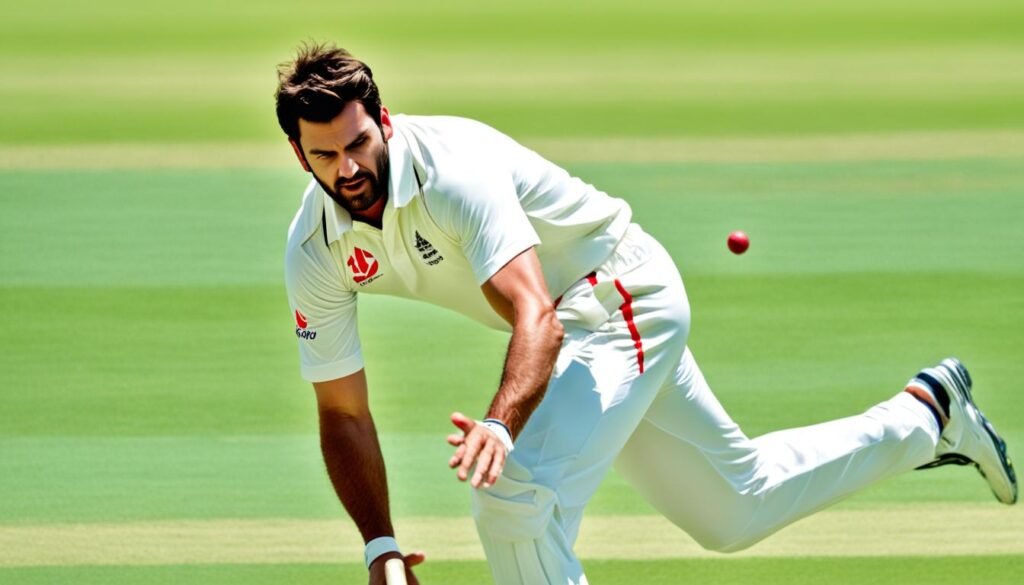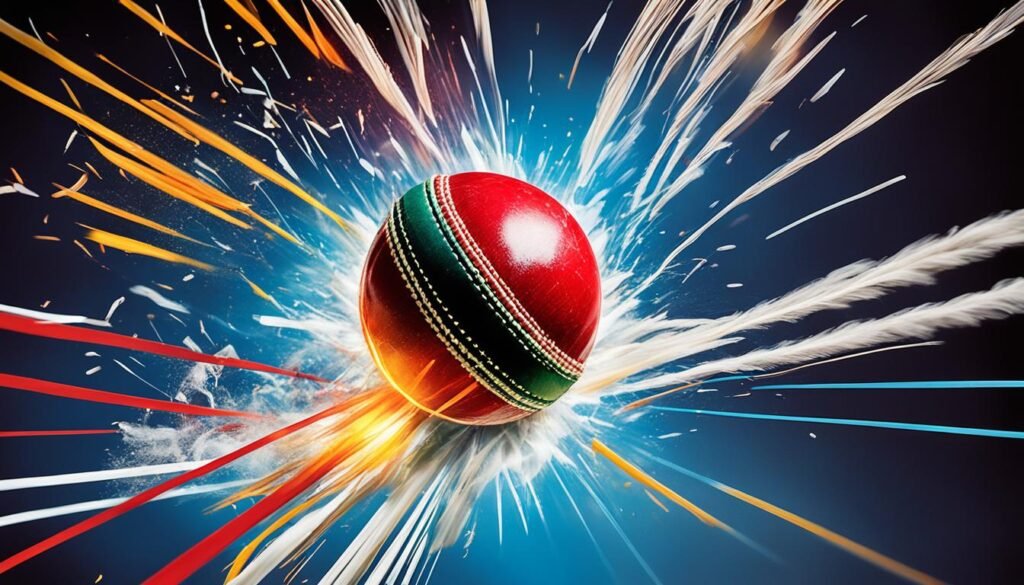Cricket Swing bowling is a technique in cricket that makes the ball move sideways in the air. The bowler tries to make the ball change direction as it heads to the batsman. This sideward movement is called “swing.” It happens from how the air flows around the ball, changing its path.
Key Takeaways : cricket swing bowling
- Swing bowling is a technique in cricket that causes the ball to move sideways in the air.
- The goal of swing bowling is to deceive the batsman by making the ball change direction unexpectedly.
- Swing bowling is a subset of fast bowling, and the practitioners are called swing bowlers.
- The movement of the ball is caused by differences in airflow around the ball, creating pressure differences.
- Swing bowling can be classified as conventional swing (outswing and inswing) and reverse swing.
Introduction to Swing Bowling
In cricket, swing bowling is a skill used to make the ball move sideways. It’s done to confuse the batsman. This sideways movement happens because of differences in air pressure around the ball. As the ball moves, it deviates, making it hard for the batsman to hit it straight. This technique falls under fast bowling. Those who master it are known as swing bowlers.
Defining Swing Bowling
Swing bowling is key in cricket as it adds an element of surprise. Bowlers use the air around the ball to make it curve. It can go away from or towards the batsman. Such movement makes it tough for the batsman to determine the ball’s path and hit it well.
Importance of Swing Bowling in Cricket
For fast bowlers in cricket, knowing how to swing the ball is critical. It lets them outsmart the batsmen. The ball can move unpredictably, forcing hard decisions from the batsman. This can lead to the batsman getting out in many ways. Thus, swing bowling is a vital skill for fast bowlers.
Conventional Swing
Conventional swing is a key skill in cricket. It makes the ball move sideways as it flies to the batsman. This movement can make the ball go away from or towards the batsman, depending on the throw.
Outswing Delivery
To make an outswinger, a bowler aims the ball slightly to the left. They put the rough side of the ball on the left too. This makes the ball move away from the batsman, often curving to the outside. Many great bowlers have used this technique, like Malcolm Marshall and Dale Steyn.
Inswing Delivery
For an inswinger, bowlers do the opposite. They aim the ball a bit to the right and place the rough part on the right. This makes the ball curve towards the batsman, mainly towards the leg side. It’s a tricky move for batsmen, as it might hit the wickets if they’re not careful.
Seam Position and Wrist Position
How the seam is aligned and the wrist is held makes or breaks swing. A 20-degree angle is key for making the ball curve. The bowler can tweak their wrist to get more curve, favoring either to go towards the batsman or away.
Bowling Action and Release Point
How a bowler bowls and releases the ball also impacts the swing. They need a smooth action that doesn’t disrupt the ball’s seam. The point of release decides the ball’s spin and path, which affects the swing.
The Aerodynamics of Swing Bowling

Air moving around the cricket ball is vital for making it swing. When the ball moves, air sticks to its surface, making a “boundary layer.” This layer can be smooth (laminar) or chaotic (turbulent). Changing between these states creates pressure differences that cause swing.
Laminar and Turbulent Airflow
The seam on a cricket ball is key for swing to happen. By adjusting the seam angle, a bowler can change how air flows around the ball. This change makes the boundary layer go from smooth to turbulent. The pressure difference this creates makes the ball swing.
The Role of the Seam
The uneven airflow around a cricket ball is what makes it swing. One side of the ball has smooth airflow, and the other is turbulent. This causes a pressure difference. The ball then moves towards the side with less pressure, affecting how it swings.
Pressure Differences and Lateral Movement
The way air moves around a cricket ball is critical for getting it to swing. This air creates a boundary layer around the ball. Depending on the airflow, this layer can be smooth or chaotic. These differences in airflow and pressure make the ball swing.
Cricket Swing Bowling

Polishing the Ball
One key tactic in cricket for swing bowlers is to shine one side of the ball. They do this by using sweat, saliva, or other things. This keeps one side smooth and allows the other to get rough. The difference helps the ball move in the air in a special way.
Maintaining the Shine
Keeping one side of the cricket ball shiny is crucial for swing bowlers. They and their teams work to maintain this shine during the whole match. They use their clothes and more to keep that side as smooth as possible. This is vital for the special way the ball moves through the air.
Factors Affecting Swing

The condition of the cricket ball matters a lot for swing bowling. A new ball with a clearly defined seam and a shiny side swings easily. When the ball is fresh, the bounce can be predictable. But, as it gets older, with rough sides, conventional swing lessens, and reverse swing may kick in.
Bowling Speed
Bowling speed plays a big role in how effective swing can be. Ideal speeds for classic swing are between 47 km/h and 128 km/h (30 mph to 80 mph). Within this range, the ball’s airflow changes from smooth to turbulent, creating swing. However, speeds over 128 km/h (80 mph) can make the airflow too turbulent. This decreases the pressure difference necessary for a strong swing.
Environmental Conditions
The environment, with its temperature, humidity, and breeze, can impact swing too. Cold, dense air can make the ball swing more by emphasizing the differences in airflow. When humidity is high, close to 100%, a temporary boost in swing might occur due to the “condensation shock.” The wind’s direction and its speed also matter. It can help or hinder swing, based on if it supports or goes against the ball’s natural motion.
Reverse Swing
Reverse swing makes the cricket ball move unexpectedly. The air over its sides changes, creating a pressure difference. This pushes the ball in the “reverse” direction. Bowlers throw the ball fast, over 85 mph, which is when the sides’ airflow interaction changes. This leads to the reverse swing effect.
The Science Behind Reverse Swing
Reverse swing mostly happens with older cricket balls. They get rough from the game’s wear and tear. One side of the ball gets polished, and the other side gets rougher. The rough side disturbs the air more than the smooth side. This difference causes the ball to swing in the opposite direction.
Bowling with an Older Ball
Fast bowlers find reverse swing very useful with an aged ball. As the ball gets rough and one side stays smooth, it swings in the opposite direction. This skill helps bowlers trick the batsmen, especially as the ball ages. It becomes a key strategy for bowlers over time.
Contrast Swing
Contrast swing is a mix of regular and reverse swing in one or more balls. The ball starts going one way but turns the other as it reaches the batsman. This change can surprise and confuse the batsman. The bowler must carefully handle the ball and the way it moves to achieve this effect.
Mastering the Art of Swing Bowling
The way a bowler stands and how they let go of the ball matters a lot for swing. By tilting the ball’s seam around 20 degrees, they can cause air to flow differently. This makes the ball either curve away from the batter (outswing) or towards them (inswing). The angle they release the ball at also affects how it moves, influencing its swing.
Seam Position and Wrist Position
Keeping the seam in the same spot and the wrist in a specific position is key for swing. A bowler aims for a certain grip to start and maintains this grip. This sets up the right air patterns around the ball. They might also change their wrist’s angle to get the desired swing direction. An open wrist helps with inswing, and a closed wrist helps get outswing.
Enhancing the Swing
Pro bowlers work hard to enhance how their ball swings. They use special creams on it and take care of its surface. Small changes in their motion and where they let go of the ball can make a huge difference. This shows their deep understanding of the physics behind swing bowling. It helps them keep batsmen on edge during matches.
Famous Swing Bowlers
Throughout cricket history, a few fast bowlers stand out for their skill in swing bowling. Three of these legends are specially remembered for their impact on the sport.
James Anderson
James Anderson, from England, is seen as a top Swing bowler in his time. He’s known for his ability to swing the ball both ways. This has helped him trouble many batsmen worldwide.
His skill in swinging the ball, mixed with precise delivery, has been key for England. It has brought him a lot of success during his career.
Wasim Akram
Wasim Akram, from Pakistan, was a star in using Reverse swing. He could make the ball move in unexpected ways. His talent with the ball has made him one of the best in cricket history.
Waqar Younis
Waqar Younis, Akram’s fellow player from Pakistan, was also famous for his reverse swing. He could make the ball move in the air sharply even with older balls. This skill, along with his aggressive bowling, made him a hard opponent for batters.
Also Read : Master Cricket Bowling Techniques: Tips And Tricks
Conclusion
Swing bowling is not easy. It has advanced a lot over time. Through science and dedication, fast bowlers make the ball move in tricky ways. This skill is all about making it hard for the batsman by the ball moving sideways while in the air.
People love watching swing bowling. It’s a challenge for even the top cricketers. We can see that this part of the game is very important and interesting. Over time, coaches and players will keep working on new ways to swing the ball. This makes sure that swing bowling remains a key part of cricket.
The skillful use of science and technique in swing bowling shows how complex cricket is. Fast bowlers are truly skillful. They can beat the best batsmen in the world by making the ball move in the air. This reminds us of the excitement and high level of skill in this part of cricket.
FAQs
Q: What is swing bowling in cricket?
A: Swing bowling is a technique where the ball moves in the air either towards or away from the batsman. It can be conventional swing or reverse swing.
Q: What are the basic principles of swing bowling?
A: The basic principles of swing bowling involve holding the ball correctly, maintaining the condition of the ball, and utilizing the seam to generate swing.
Q: How does swing bowling work?
A: Swing bowling works by creating a difference in airflow over the two sides of the ball, causing it to move in the direction of the smoother side.
Q: What is the difference between conventional and reverse swing?
A: Conventional swing is when the ball swings in the same direction as the shiny side, whereas reverse swing is when the ball swings in the opposite direction.
Q: What is late swing in cricket?
A: Late swing refers to the movement of the ball in the later stages of its flight path, making it harder for the batsman to adjust.
Q: How can one become a better swing bowler?
A: To become a better swing bowler, one can practice holding the ball correctly, understanding the aerodynamics of swing, and working on varying the speed and angle of delivery.
Q: Where can I learn swing bowling techniques?
A: You can learn swing bowling techniques at a cricket academy or from a qualified cricket coach who specializes in bowling skills.
Q: What factors affect the amount of swing a bowler can generate?
A: Factors such as the condition of the ball, the smoothness of the seam, the bowler’s grip, and the airflow over the ball can affect the amount of swing a bowler can generate.
Q: When does reverse swing occur?
A: Reverse swing occurs when the rough side of the ball behaves differently from the shiny side, causing the ball to move in the opposite direction to conventional swing.
